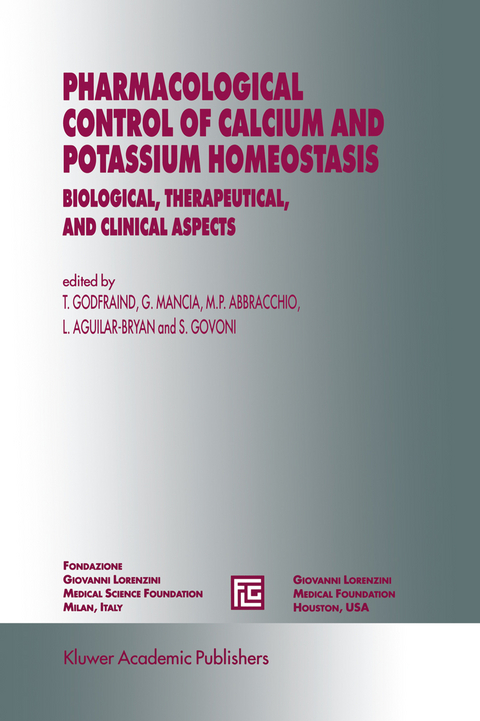
Pharmacological Control of Calcium and Potassium Homeostasis
Springer (Verlag)
978-0-7923-3604-4 (ISBN)
As the number of drugs acting on calcium and potassium channels grows, there is a need for a continuous reappraisal of the cellular machinery controlling them. The present volume provides an update on the basic knowledge, the molecular targets of the two channels, and the importance the drugs that bind them have as pharmacological tools and therapeutic agents. This work was presented at the 6th International Symposium on PHARMACOLOGICAL CONTROL OF CALCIUM AND POTASSIUM HOMEOSTASIS: BIOLOGICAL, THERAPEUTICAL, AND CLINICAL ASPECTS, in Florence (Italy) on October 4-6, 1994. Because of the recent advances in the field, discussions on potassium channels were included for the first time. At least six classes of voltage-dependent calcium channels have been defined based on their physiological and pharmacological properties. Among them, L-type channels, mediating long lasting currents, are better characterized. Calcium homeostasis within the cell is not only regulated by calcium channels; intracellular calcium stores, in particular a pool contained in the lumen of specialized areas of the endoplasmic reticulum, are rapidly exchanged with the cytoplasm and playa key role in the control of calcium homeostasis. This area, however, has not yet been exploited from a therapeutic point of view. Potassium channels are present in virtually every cell type, excitable and nonexcitable, and are distinguished by structural, biophysical, and pharmacological criteria. Different classes including voltage-gated, ligand-gated, AP-sensitive, and G-protein coupled among others, have been defined by their primary regulatory and gating mechanisms.
1. cAMP-Dependent Phosphorylation of the L-Type Calcium Channel: Biochemical Characterization and Physiological Regulation.- 2. Integration of Plasmalemmal and Sarcoplasmic Reticular Ca2+Transport in Smooth Muscle.- 3. Oligomeric and Subunit Structures of Voltage-Gated Potassium Channels.- 4. Modulation of K+ Channels: Pharmacological and Therapeutic Aspects.- 5. Calcium Channels and Regulation of Vascular Tone in Hypertension.- 6. Calcium and Calcium Channel Regulation in Cardiac Function.- 7. Adenosine and ATP-Regulated Ion Currents in Cardiomyocytes.- 8. Endothelium-Dependent Hyperpolarization and Potassium Channels.- 9. Potassium Channels in the Regulation of Vascular Smooth Muscle Tone.- 10. The Importance of Potassium for Vascular Protection in a Hypertensive Setting.- 11. The Antiatherosclerotic Effect of Calcium Antagonists.- 12. Clinical Pharmacology of Calcium Antagonists as Antihypertensives.- 13. Cardioprotection by Calcium Antagonists: Myocardial Ischemia and Secondary Prevention.- 14. Actions of Insulin and IGF-I on Vascular Smooth Muscle Cation and Glucose Metabolism.- 15. The Prevention of Vascular Injury in a Genetic Model of Hypertension.- 16. Calcium Antagonists and Renal Protection: Current Status and Future.- 17. The Reversal of Hypertension-Induced Cardiac Damage by Antihypertensive Therapy with Calcium Antagonists.- 18. Rationale for Combined Therapy with Calcium Antagonists and ACE Inhibitors.- 19. Does the Combination of an ACE Inhibitor and a Calcium Antagonist Enhance Cardioprotection?.- 20. Hypertension in Diabetic Patients: How to Preserve Renal Function.- 21. Multicenter Isradipine Diuretic Atherosclerosis Study (MIDAS): Rationale, Design, and Description of Trial Patients.- 22. Metabolic Changes Associated with Isradipine and Hydrochlorothiazide in MIDAS: Effects on Serum Cations and Uric Acid.- 23. Ionic Metabolism in Cerebral Ischemia.- 24. New Directions in Cerebral Ischemia: Sodium and Calcium Channel Modulators.- 25. Acute Ischemic Stroke Therapy.- 26. Potassium Channels and Internal Calcium Release: Relevance for Memory Storage and Alzheimer’s Disease.- 27. Molecular Physiology of a Novel cGMP-Gated Potassium Channel.- 28. ATP-Dependent K+ Channels in Vascular Smooth Muscle.- 29. Potassium Channel Openers in Therapy: Current Use and Perspective in Hypertension.- 30. Potassium Channel Openers in Therapy, Current Uses, and Perspectives: Cardiac Ischemia and Angina.
| Erscheint lt. Verlag | 31.7.1995 |
|---|---|
| Reihe/Serie | Medical Science Symposia Series ; 9 |
| Zusatzinfo | XVIII, 275 p. |
| Verlagsort | Dordrecht |
| Sprache | englisch |
| Maße | 170 x 244 mm |
| Themenwelt | Medizinische Fachgebiete ► Innere Medizin ► Kardiologie / Angiologie |
| Medizin / Pharmazie ► Medizinische Fachgebiete ► Neurologie | |
| Medizin / Pharmazie ► Medizinische Fachgebiete ► Pharmakologie / Pharmakotherapie | |
| ISBN-10 | 0-7923-3604-6 / 0792336046 |
| ISBN-13 | 978-0-7923-3604-4 / 9780792336044 |
| Zustand | Neuware |
| Informationen gemäß Produktsicherheitsverordnung (GPSR) | |
| Haben Sie eine Frage zum Produkt? |
aus dem Bereich


